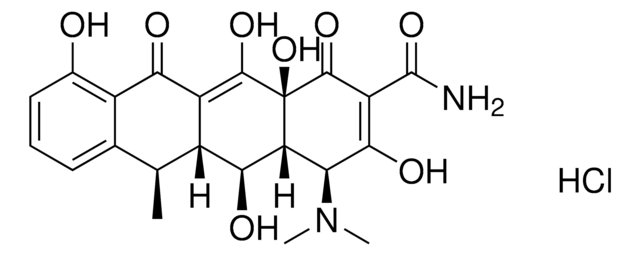추천 제품
분석
≥98%
Quality Level
양식
liquid
농도
10 mg/mL in water
항생제 활성 스펙트럼
Gram-positive bacteria
neoplastics
parasites
동작 모드
protein synthesis | interferes
저장 온도
2-8°C
SMILES string
N[C@H]1[C@@H](O)[C@H](N(C=N2)C3=C2C(N(C)C)=NC=N3)O[C@@H]1CO
InChI
1S/C12H18N6O3/c1-17(2)10-8-11(15-4-14-10)18(5-16-8)12-9(20)7(13)6(3-19)21-12/h4-7,9,12,19-20H,3,13H2,1-2H3
InChI key
RYSMHWILUNYBFW-UHFFFAOYSA-N
생화학적/생리학적 작용
Puromycin aminonucleoside is an aminonucleoside derivative of the known antibiotic puromycin. Puromycin aminonucleoside has been used in nephrology research, studying focal and segmental glomerulosclerosis, and in the induction of nephrosis in rats. Rats with puromycin aminonucleoside-induced nephrotic syndrome were used to study the excretion of sodium and NOx metabolites.
Puromycin aminonucleoside has also been used to probe endothelial glycosaminoglycan synthesis in cultured glomerular endothelial cells and their relation to cell permeability. A puromycin aminonucleoside nephrosis model of rat glomerular disease was also used to study the role of the neuron-specific ubiquitin C-terminal hydrolase protein gene product 9.5 (PGP 9.5).
Puromycin aminonucleoside has also been used to probe endothelial glycosaminoglycan synthesis in cultured glomerular endothelial cells and their relation to cell permeability. A puromycin aminonucleoside nephrosis model of rat glomerular disease was also used to study the role of the neuron-specific ubiquitin C-terminal hydrolase protein gene product 9.5 (PGP 9.5).
제조 메모
Puromycin aminonucleoside solution is provided at 10 mg/mL in water and could be further diluted in aqueous buffers to a working concentration of 10 μg/mL (1:1000).
Storage Class Code
10 - Combustible liquids
WGK
WGK 2
Flash Point (°F)
Not applicable
Flash Point (°C)
Not applicable
가장 최신 버전 중 하나를 선택하세요:
이미 열람한 고객
Khalil Udwan et al.
The Journal of biological chemistry, 291(21), 11105-11113 (2016-04-02)
Water accumulation in the interstitium (edema) and the peritoneum (ascites) of nephrotic patients is classically thought to stem from the prevailing low plasma albumin concentration and the decreased transcapillary oncotic pressure gradient. However, several clinical and experimental observations suggest that
Agnes B Fogo
Seminars in nephrology, 23(2), 161-171 (2003-04-22)
Glomerulosclerosis in a heterogeneous pattern, ie, focal and segmental glomerulosclerosis (FSGS), is a common endpoint in a variety of settings, including idiopathic FSGS, and scarring secondary to other renal or systemic diseases. These different causes contribute to the diverse clinical
I Shirato et al.
Journal of the American Society of Nephrology : JASN, 11(12), 2381-2386 (2000-11-30)
Parietal epithelial cells (PEC) of Bowman's capsules cover the inner aspect of Bowman's capsules and are believed to contribute to extracapillary lesions of glomerulonephritis such as crescent formation. In glomerular research including cell culture experiments and pathology, differentiation between PEC
Jenny Sörensson et al.
American journal of physiology. Renal physiology, 284(2), F373-F380 (2002-10-22)
It has been suggested that proteinuria is caused by alterations of the charge selectivity of the basement membrane and/or the epithelial cell layer (podocytes). However, recent findings suggest that the endothelial luminal surface coat, consisting of proteoglycans with their connected
Alicia A McDonough et al.
Current opinion in nephrology and hypertension, 12(5), 533-541 (2003-08-16)
The proximal tubule sodium/hydrogen exchanger continuously reabsorbs the bulk of the filtered sodium, controlling salt delivery to the distal nephron which is critical for tubuloglomerular feedback autoregulation and for fine control of salt excretion in the distal nephron. This review
자사의 과학자팀은 생명 과학, 재료 과학, 화학 합성, 크로마토그래피, 분석 및 기타 많은 영역을 포함한 모든 과학 분야에 경험이 있습니다..
고객지원팀으로 연락바랍니다.








